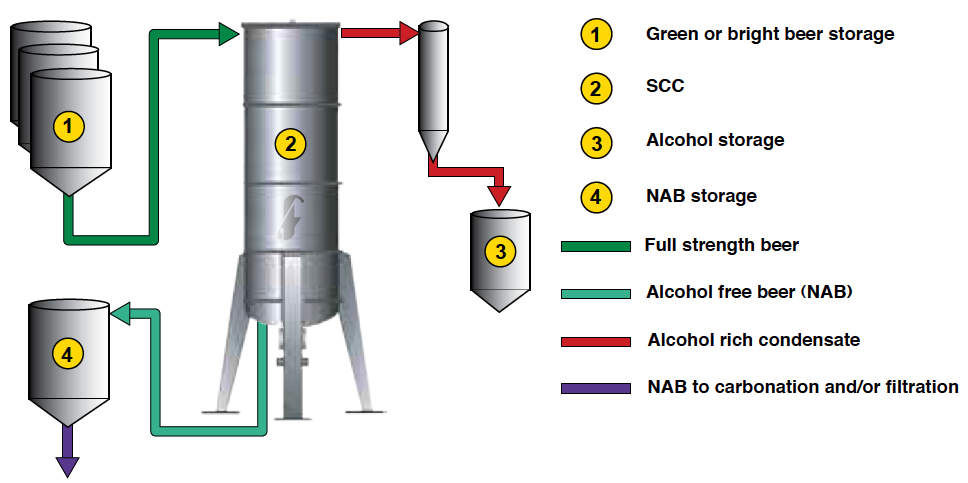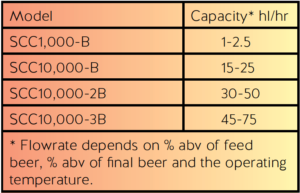Beer Dealcoholization
Brewers have been using Flavourtech’s SCC Beer Dealcoholization technology for a number of years to improve the taste quality of non-alcohol and low-alcohol beer products. It is a very gentle process compared to standard extraction techniques and enables better capture of aromas and flavors in a natural way.
The Beer Dealcoholization Process
The Spinning Cone Column (SCC) is an efficient and versatile steam stripping column. One of the many commercial applications for this unique technology is alcohol removal from full strength beer for the production of Non-Alcoholic Beer (NAB) and Low Alcohol Beer (LAB). Traditional techniques for producing NAB or LAB have a number of undesirable aspects, including:
- Production of an inferior quality product due to high thermal impact
- High utility consumption requirements or effluent streams
- Can, in some cases, unnecessarily complicate the production process by requiring degassing and possibly additional filtration
In contrast, the key benefits of the SCC for when processing beer are:
- Reduction of alcohol content in full strength beers to <0.05% ABV continuously in a single pass and with no product damage
- Significantly lower utility consumption when compared to alternative technologies
- No external reflux thus limiting residence time and avoiding unnecessary exposure of the product to elevated temperatures
- No concentration of the beer stream during de-alcoholization (hence no make-up water required and a better quality)
- Ability to process unfiltered beer thus increasing productivity by removal of a filtration step
- No need to de-gas the feed beer prior to de-alcoholization
- Option to recover beer aroma from alcoholic condensate
- Multipurpose plant that can produce both NAB and LAB
- Stripping steam is produced by means of a pure steam generator
- A high strength and high quality spirit is produced
- Hygienic design with full Clean-In-Place (CIP) capabilities
- No effluent problems
The SCC is now installed in breweries around the world for the production of premium quality NAB and LAB products.
The Spinning Cone Column
The SCC is a uniquely efficient counter-current liquid-gas contacting device, a distillation or stripping column that belongs to the same family of mass transfer devices as packed, plate and bubble-cap columns. The SCC is unique in its use of gentle mechanical forces to enhance inter-phase contact. This allows the rapid, efficient and cost-effective separation of volatile compounds, such as aroma and alcohol, from a thin-film liquid system. The SCC can process thick viscous slurries containing high levels of suspended solids, just as readily as it can process clear liquids, without damaging the recovered flavor or the treated product.
No Damage to the Product
Beer made by the SCC is generally considered superior to NAB and LAB products made by other techniques. A major reason for this is that the thermal impact experienced by the beer within the SCC is minimal. Several factors
contribute to minimizing the thermal impact:
- Short residence time. The time for the product to travel through the column is around 30 seconds
- Low operating temperature – typically, in the range of 28°C (82.4°F) to 45°C (113°F). Moreover, there is very low pressure drop across the column, meaning low temperatures are maintained throughout. These low operating temperatures reduce thermal damage to the beer
- No external reflux thus avoiding product recycling and extended residence times. In addition, the absence of external reflux and the high mass transfer efficiency of the SCC means that equilibrium is reached virtually instantaneously
Basic process schematic for NAB production
Low Energy Costs
Due to the unique design, the SCC has very low energy usage. Aspects contributing to the low energy requirements include:
- High mass transfer efficiency (low steam consumption)
- No reflux (reduces steam and coolant consumption)
- No product recycle (reduces steam and coolant consumption)
- Use of heat recovery where possible (reduces steam consumption)
- Simplicity (lower electricity usage)
Simultaneous De-gassing and Alcohol Removal
The feed beer to the SCC may have up to 5 g/L CO2 avoiding the need to de-gas the beer prior to de-alcoholization and subsequently simplifying the process.
Processing Unfiltered Beer
A major advantage of the SCC, when compared to alternative devices used for alcohol reduction, is its ability to process unfiltered beer. Specifically, the SCC can readily process “young” or “unfiltered” beer, as well as beer directly from the maturation tanks, thus avoiding additional filtration. Due to the unique design of the SCC, the residues and suspended particles present in unfiltered beer pass through the device without blocking and causing CIP problems. Alternate distillation devices (such as packed or plate columns) require the feed beer to be filtered as they cannot process beer containing solids. The reason is that in these devices, suspended solids tend to build up on product contact surfaces and gradually reduce the performance of the system, ultimately leading to major cleanability issues.
Generation of Stripping Steam
The SCC uses a flow of high quality stripping steam to remove the alcohol. If food grade steam is unavailable on site, a Steam Generator can be included in the system supply. This consists of a heat exchanger, controlled by the SCC automation system, to convert a supply of treated water (typically de-ionized water with <3ppm TDS) into stripping steam using factory steam as the heating medium.
Low Alcohol Beer Production
For production of Low Alcohol Beer, a two stage process is used whereby the volatile beer flavor is first removed from the beer using the SCC. This flavor is stored separately while the de-flavored beer is passed again through the SCC to remove the alcohol. The de-alcoholized beer is then blended with the flavor fraction and full strength beer (if required) to produce the finished product at the desired alcohol level.
Non-Alcoholic Beer Production
For production of Non-Alcoholic Beer (<0.05% abv) it is not possible to add back the concentrated alcoholic aroma condensate generated in the two stage approach above due to the requirement to produce a final product at <0.05% abv. Flavourtech has therefore developed the Resin Adsorbing Column (RAC) that can be added to the SCC allowing beer aroma compounds to be completely separated from the alcoholic condensate generated during the de-alcoholization process. As a result, a more flavorsome Non-Alcoholic Beer can be produced than was previously possible.
Beer Dealcoholization Models
Two models are available; SCC1,000-B and SCC10,000-B. Nominal capacities for alcohol reduction of beer are given in the table below. Maximum throughput can be increased using a higher operating temperature and/or reduced level of alcohol reduction. If the processing capacity is greater than that achievable on the largest single column plant, then a system is constructed with parallel columns. Such multiple column systems share feed, discharge, condensing and control systems.
Further details regarding the operating principle of the SCC may be found at www.flavourtech.com



